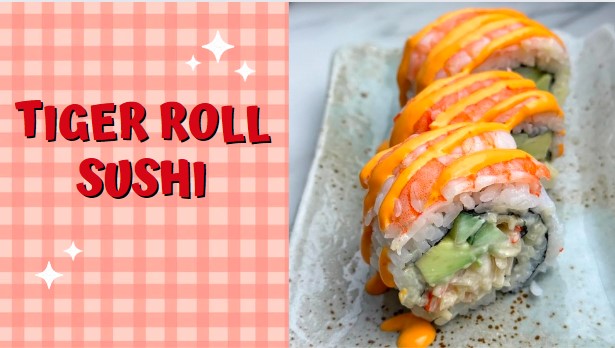Tiger Roll sushi is a visually stunning and delicious variety of sushi that captivates with its vibrant colors and exquisite taste. This sushi roll typically features a tantalizing blend of ingredients such as shrimp tempura and creamy avocado, all wrapped snugly in a sheet of seaweed. The outer layer often boasts thinly sliced avocado or a sprinkle of fish roe, giving the roll its characteristic “tiger stripes” appearance that is both appetizing and artistic.
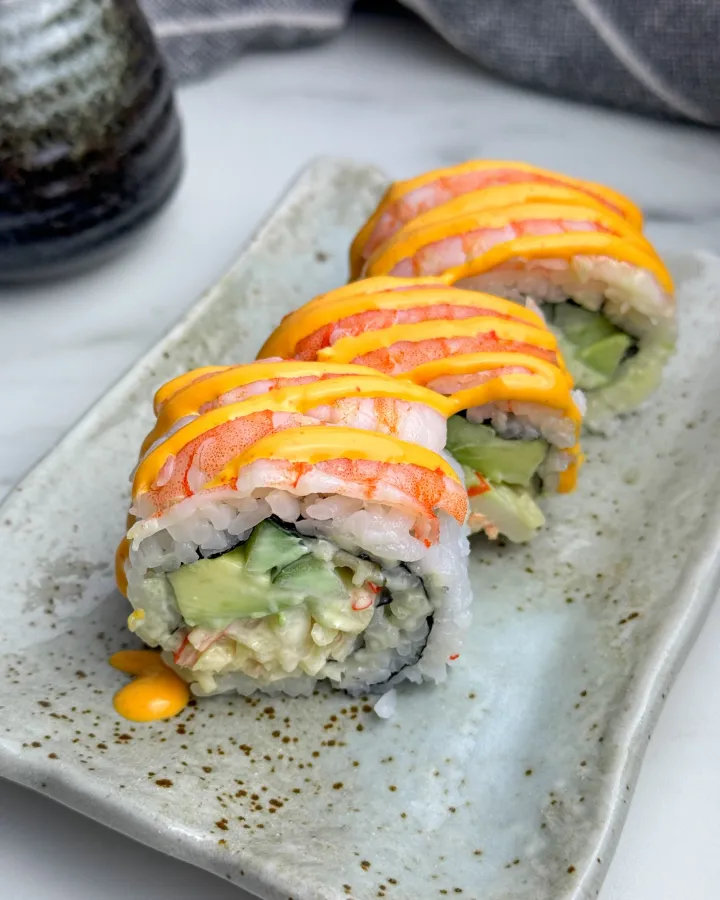
The interplay of textures in a Tiger Roll is particularly noteworthy. The crispy, warm shrimp tempura provides a delightful contrast to the cool, smooth avocado, making each bite a balanced fusion of flavors. Often drizzled with a sweet and slightly spicy mayo or a savory eel sauce, the roll is elevated to a new level of flavor intensity.
Ideal for both sushi novices and connoisseurs, the Tiger Roll offers a delectable introduction to the art of sushi with its approachable flavors and striking presentation. It serves not only as a satisfying meal but also as a conversation starter, perfect for sharing at gatherings or enjoying as a special treat.
Kitchen Tools Needed
Ingredients for Tiger Roll Sushi
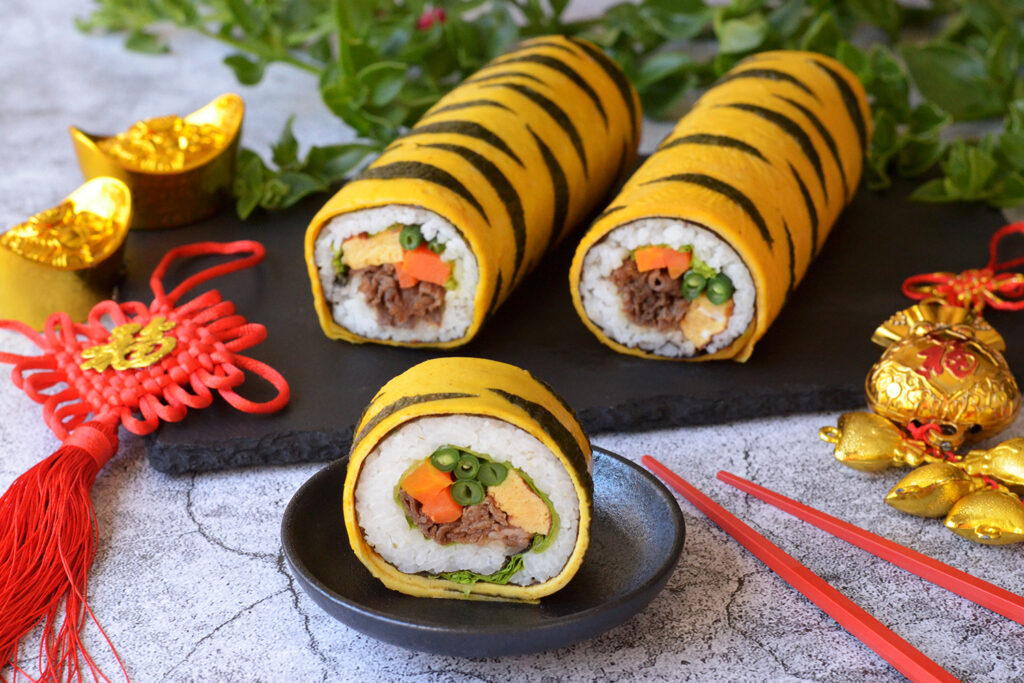
Rice and Seasoning
Filling
Outer Layer and Toppings
Sauce
How To Make Tiger Roll Sushi?
Preparing the Sushi Rice
Begin by rinsing the sushi rice under cold water until the water runs clear. This removes excess starch and prevents the rice from being too sticky. Cook the rice in a rice cooker or a saucepan with the measured water. Once cooked, let it sit covered for about 10 minutes to steam. Meanwhile, mix rice vinegar, sugar, and salt in a small saucepan and heat gently until the sugar dissolves. Transfer the cooked rice to a wooden or plastic container (avoid metal as it reacts with the vinegar). Pour the vinegar mixture over the hot rice and gently fold it in with a rice paddle or a wooden spoon, fanning the rice simultaneously to help it cool and absorb the seasoning.
Preparing the Fillings
Cook the shrimp tempura according to package instructions until crispy. Let it cool slightly before assembly. Slice the avocado into thin slices. If using avocado for the topping, slice extra and keep it aside.
Assembling the Tiger Roll
Place a bamboo sushi mat on your work surface and cover it with plastic wrap to prevent sticking. Lay a sheet of nori on the mat, shiny side down. With wet hands, spread a thin layer of sushi rice evenly over the nori, leaving about an inch uncovered at the far end. Arrange two pieces of shrimp tempura along the center of the rice and line up some avocado slices next to the tempura.

Rolling the Sushi
Lift the edge of the mat closest to you, keeping the fillings in place with your fingers, and roll it over the fillings to enclose them in rice and nori. Continue rolling, applying gentle pressure to keep the roll tight. Once the roll is complete, wrap it in the mat and gently squeeze to shape it firmly.
Adding the “Tiger Stripes”
For the outer layer, if using tobiko, spread it over the top of the roll. If using avocado, lay thin slices across the top of the roll, then cover with plastic wrap and gently press into shape with the sushi mat to adhere the avocado to the surface, giving it the striped look.
Cutting the Tiger Roll
Using a sharp knife, slice the roll into 8 equal pieces. Dip the knife in water between cuts to ensure a clean slice without tearing.
Serving
Arrange the sushi pieces on a plate and drizzle with spicy mayo and eel (unagi) sauce for added flavor. Serve with pickled ginger, wasabi, and soy sauce on the side for dipping.
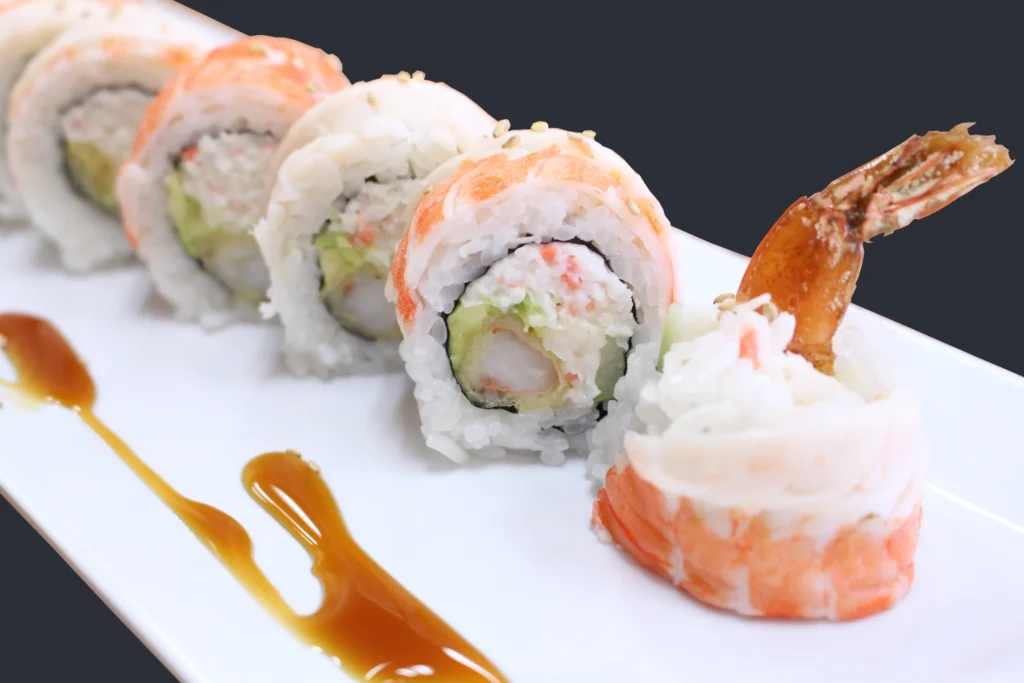
What to serve with Tiger Roll Sushi ?
Health Benefits
Rich in Omega-3 Fatty Acids: The shrimp in Tiger Roll sushi is an excellent source of omega-3 fatty acids, which are crucial for heart health and can help reduce inflammation throughout the body.
High in Protein: Both the shrimp tempura and the rice provide a good source of protein, which is essential for muscle repair and growth. Protein also helps in making you feel fuller for longer, aiding in weight management.
Provides Healthy Fats: Avocado, a staple in Tiger Rolls, is high in monounsaturated fats. These healthy fats are good for heart health and help lower bad cholesterol levels.
Source of Vitamins and Minerals: Avocado is also a great source of vitamin K, vitamin E, potassium, and folate. These nutrients are vital for maintaining overall health, from bone density to skin elasticity.
Dietary Fiber: Avocado offers dietary fiber, which promotes digestive health and helps maintain regular bowel movements. Fiber can also help regulate blood sugar levels.
Low Calorie: When prepared with attention to the freshness and quality of ingredients, and depending on the use of sauces, Tiger Roll sushi can be a low-calorie meal option that satiates without adding excessive calories.
Antioxidant Benefits: The various components of Tiger Roll, including the vegetables and seaweed, contribute antioxidants that help combat oxidative stress and may reduce the risk of chronic diseases.
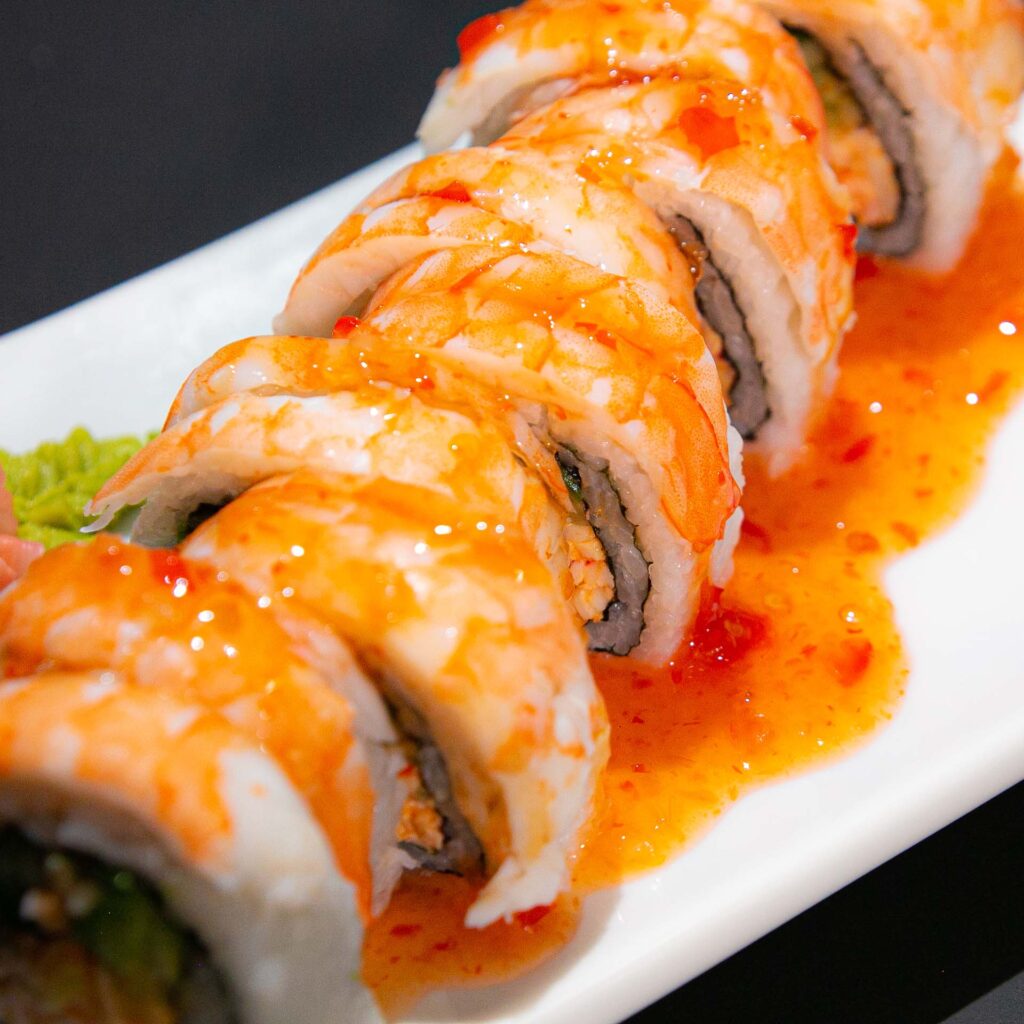
Tips and Tricks
Choose Fresh Ingredients: Always select the freshest shrimp and ripe avocados. Fresh ingredients not only taste better but also hold together well during the rolling process.
Prepare Shrimp Tempura Perfectly: Ensure your shrimp tempura is crispy and not oily by maintaining the oil at the correct temperature. If the oil is too hot, the batter will burn; if it’s too cool, the batter will absorb too much oil and become soggy.
Spread Rice Evenly: When spreading the rice on the nori sheet, keep your hands wet to prevent sticking. Aim for an even, thin layer so that the roll is not too bulky, which makes it easier to roll and eat.
Slice Avocado Thinly: Thin slices of avocado are easier to roll and create a more elegant presentation. Use a sharp knife to achieve smooth, even slices.
Use a Bamboo Mat for Tight Rolling: Cover your bamboo mat with plastic wrap to prevent sticking and achieve a tighter roll. The mat also helps to evenly distribute pressure across the roll, ensuring that the ingredients stay intact.
Keep Ingredients Centered: Place your fillings in the center of the rice on the nori sheet. This positioning helps ensure that the ingredients are evenly distributed when the sushi is sliced.
Apply Gentle Pressure: When rolling the sushi, apply gentle but firm pressure to keep everything compact. Too much force can cause ingredients to ooze out the sides.
Chill Before Cutting: After rolling your sushi, wrap it in cling film and refrigerate for about 30 minutes. This firmness makes it easier to cut clean slices without squishing the roll.
Use a Sharp Knife: A sharp knife is crucial for cutting sushi. Wet the blade with water or rice vinegar to prevent sticking and to ensure smooth, clean cuts through the roll.
Experiment with Toppings: While tobiko and avocado are traditional, feel free to experiment with other toppings like sesame seeds, teriyaki sauce, or thinly sliced lemon for added flavor and visual appeal.
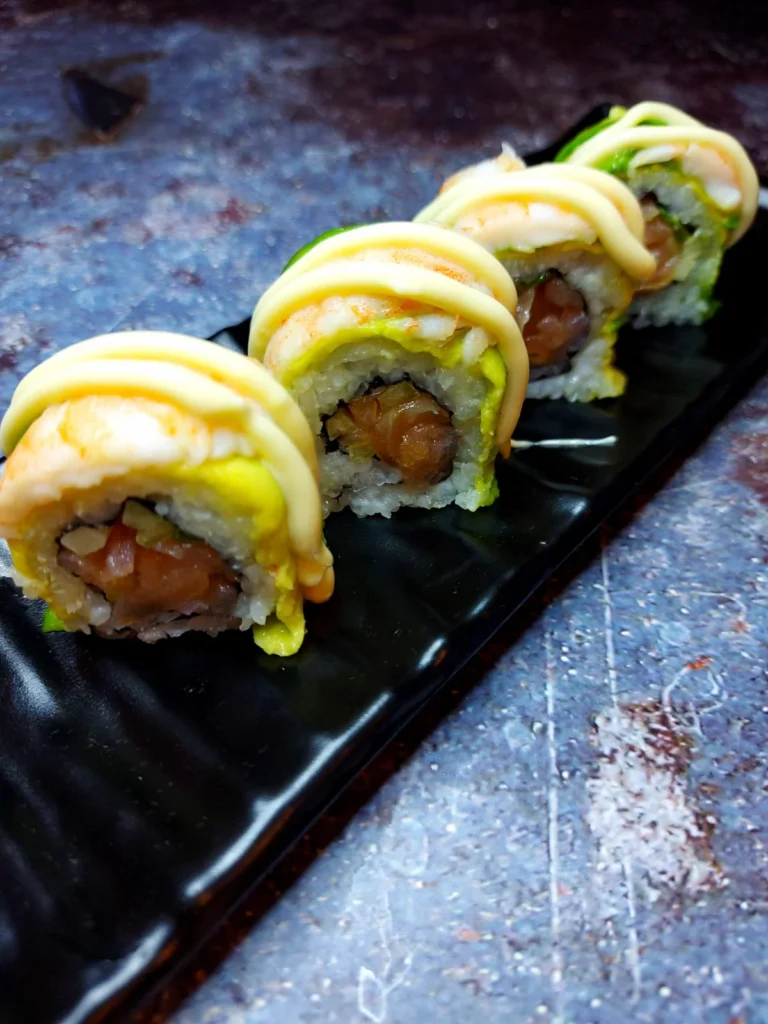
Variations of Tiger Roll Sushi
Substitutions for Tiger Roll Sushi
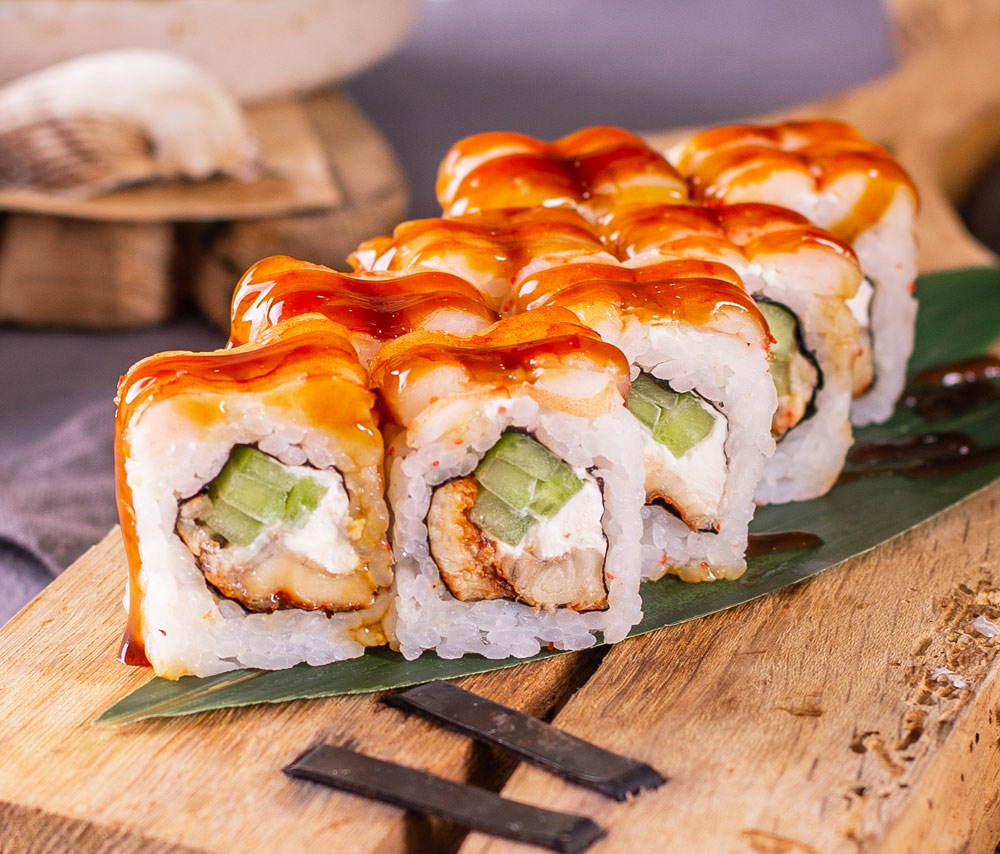
Making Ahead
Tiger Roll sushi is best enjoyed fresh, but you can prepare some components ahead of time to streamline the assembly process. Prepare the sushi rice and season it up to a day in advance; keep it covered at room temperature. Shrimp tempura can also be made ahead and stored in the refrigerator, though it’s best to reheat it before assembling to maintain its crispiness.
Storage
If you need to store Tiger Roll sushi, wrap each roll tightly in plastic wrap to prevent the rice from drying out and the ingredients from losing their freshness. Place the wrapped rolls in an airtight container and store in the refrigerator. Ideally, consume stored sushi within 24 hours, as the quality deteriorates quickly.
Reheating
Reheating Tiger Roll sushi is generally not recommended, especially if it contains raw toppings or fillings, as it can affect the texture and freshness. However, if your sushi contains only cooked ingredients like shrimp tempura, you can briefly reheat the tempura in the oven or in an air fryer to bring back its crunch before assembling the sushi. Ensure that any reheating process is quick to prevent the shrimp from becoming too tough or dry.
Nutritional Facts (Per Serving)
Micronutrients
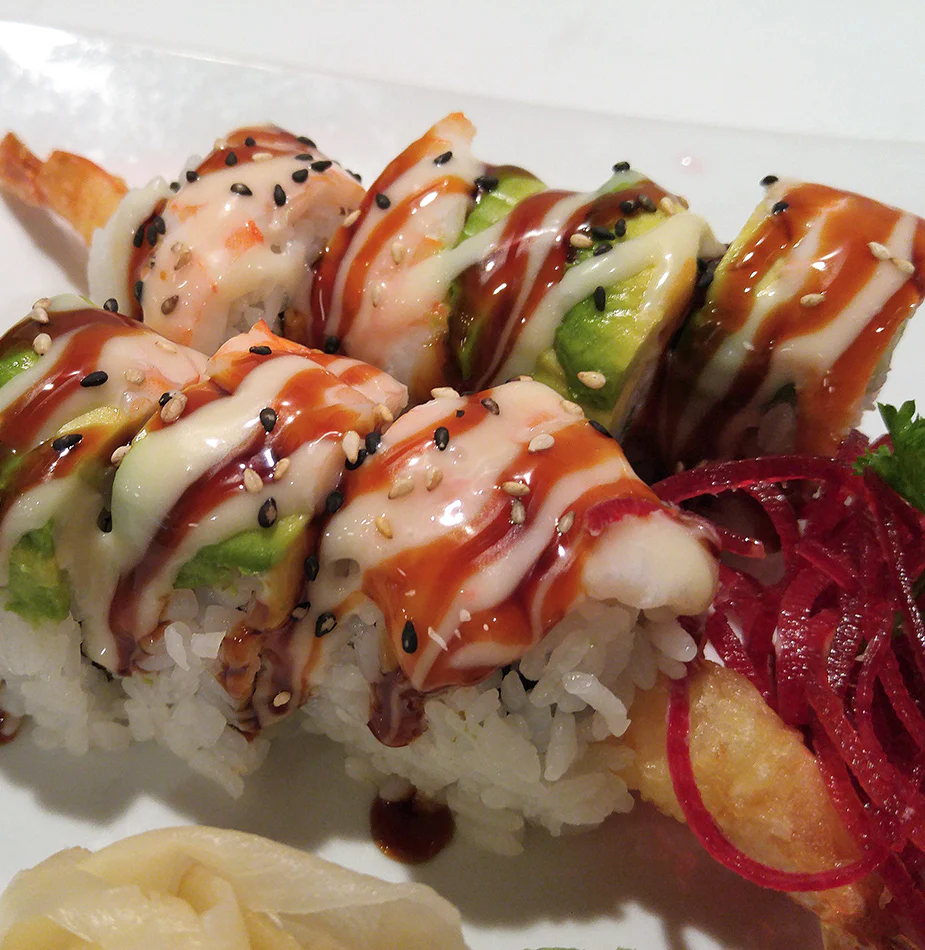
Delicious Meal Ideas
Super Yummy Alaska Roll Sushi Recipe| 5 Best Sushi Sauces Recipes
Delicious Spicy Shrimp Roll Recipe
Frequently Asked Questions – FAQ’s
Tiger Roll Sushi
Course: MainCuisine: JapaneseDifficulty: Easy4
servings20
minutes10
minutes350
kcalIngredients
Rice and Seasoning:
2 cups of Sushi Rice
2 1/2 cups of Water
1/4 cup of Rice Vinegar
2 tablespoons of Sugar
1 teaspoon of Salt
Filling:
8 pieces of Shrimp Tempura (2 per roll)
1 Avocado, thinly sliced
Outer Layer and Toppings:
1/2 cup of Tobiko (flying fish roe) or thinly sliced avocado for the “tiger stripes”
4 sheets of Nori (seaweed)
Sauce:
Spicy Mayo (mix mayonnaise with Sriracha or a similar hot sauce to taste)
Eel Sauce (available in most Asian groceries)
Directions
- Begin by rinsing the sushi rice under cold water until the water runs clear. This removes excess starch and prevents the rice from being too sticky. Cook the rice in a rice cooker or a saucepan with the measured water. Once cooked, let it sit covered for about 10 minutes to steam. Meanwhile, mix rice vinegar, sugar, and salt in a small saucepan and heat gently until the sugar dissolves. Transfer the cooked rice to a wooden or plastic container (avoid metal as it reacts with the vinegar). Pour the vinegar mixture over the hot rice and gently fold it in with a rice paddle or a wooden spoon, fanning the rice simultaneously to help it cool and absorb the seasoning.
- Cook the shrimp tempura according to package instructions until crispy. Let it cool slightly before assembly. Slice the avocado into thin slices. If using avocado for the topping, slice extra and keep it aside.
- Place a bamboo sushi mat on your work surface and cover it with plastic wrap to prevent sticking. Lay a sheet of nori on the mat, shiny side down. With wet hands, spread a thin layer of sushi rice evenly over the nori, leaving about an inch uncovered at the far end. Arrange two pieces of shrimp tempura along the center of the rice and line up some avocado slices next to the tempura.
- Lift the edge of the mat closest to you, keeping the fillings in place with your fingers, and roll it over the fillings to enclose them in rice and nori. Continue rolling, applying gentle pressure to keep the roll tight. Once the roll is complete, wrap it in the mat and gently squeeze to shape it firmly.
- For the outer layer, if using tobiko, spread it over the top of the roll. If using avocado, lay thin slices across the top of the roll, then cover with plastic wrap and gently press into shape with the sushi mat to adhere the avocado to the surface, giving it the striped look.
- Using a sharp knife, slice the roll into 8 equal pieces. Dip the knife in water between cuts to ensure a clean slice without tearing.
- Arrange the sushi pieces on a plate and drizzle with spicy mayo and eel (unagi) sauce for added flavor. Serve with pickled ginger, wasabi, and soy sauce on the side for dipping.
Conclusion
Tiger Roll sushi is a delightful treat that combines the crispiness of shrimp tempura with the creamy richness of avocado, all wrapped in a nori sheet and adorned with striking tiger-like stripes. Whether you are new to sushi or a seasoned aficionado, the Tiger Roll offers a unique blend of textures and flavors that satisfy both visually and gastronomically.
With its versatility in ingredients and toppings, this sushi roll can be customized to cater to a variety of dietary preferences, making it a popular choice for many. Embrace the joy of making this sushi at home and experiment with different fillings and toppings to create your own version of this classic roll.

